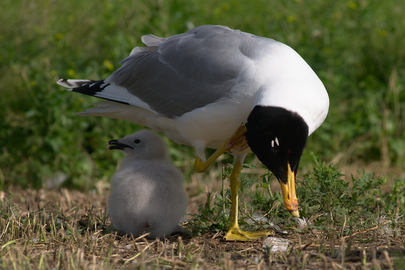
Audouin's gull is a large gull restricted to the Mediterranean and the western coast of Saharan Africa and the Iberian Peninsula. The genus name is from Ancient Greek ikhthus, "fish", and aetos, "eagle", and the specific audouinii and the English name are after the French naturalist Jean Victoire Audouin.

The Mediterranean gull is a small gull. The scientific name is from Ancient Greek. The genus Ichthyaetus is from ikhthus, "fish", and aetos, "eagle", and the specific melanocephalus is from melas, "black", and -kephalos "-headed".

The laughing gull is a medium-sized gull of North and South America. Named for its laugh-like call, it is an opportunistic omnivore and scavenger. It breeds in large colonies mostly along the Atlantic coast of North America, the Caribbean, and northern South America. The two subspecies are L. a. megalopterus — which can be seen from southeast Canada down to Central America — and L. a. atricilla, which appears from the West Indies to the Venezuelan islands. The laughing gull was long placed in the genus Larus until its present placement in Leucophaeus, which follows the American Ornithologists' Union.

The great black-backed gull is the largest member of the gull family. Described by the Cornell Lab of Ornithology as "the king of the Atlantic waterfront", it is a very aggressive hunter, pirate, and scavenger. It breeds on the European and North American coasts and islands of the North Atlantic and is fairly sedentary, though some move farther south or inland to large lakes or reservoirs. The adult great black-backed gull has a white head, neck and underparts, dark grey wings and back, pink legs and yellow bill.

The lesser black-backed gull is a large gull that breeds on the Atlantic coasts of Europe. It is migratory, wintering from the British Isles south to West Africa. However, it has increased dramatically in North America, especially along the east coast. Formerly just a winter visitor to North America, it now occurs in large numbers some winters and many birds are now spotted year-round. The species has become an annual winter visitor in California, with birds reported around most of the state, including at the Salton Sea. There is now serious concern about decline in many parts of its range. The species is on the RSPB Amber List because the UK is home to 40 per cent of the European population and more than half of these are found at fewer than ten sites.

The little gull, is a species of gull belonging to the family Laridae which is mainly found in the Palearctic with some colonies in North America. It breeds on freshwaters and spends winters at sea. It is the smallest species of gull in the world and the only species in the monospecific genus Hydrocoloeus.

The slender-billed gull is a mid-sized gull which breeds very locally around the Mediterranean and the north of the western Indian Ocean on islands and coastal lagoons. Most of the population is somewhat migratory, wintering further south to as far as North Africa and India. A few birds have wandered to western Europe. A vagrant individual was reportedly seen on Antigua, April 24, 1976.

The glaucous gull is a large gull, the second-largest gull in the world. The genus name is from Latin larus, which appears to have referred to a gull or other large seabird. The specific name hyperboreus is Latin for "northern" from the Ancient Greek Huperboreoi people from the far north "Glaucous" is from Latin glaucus and denotes the grey colour of the gull. An older English name for this species is burgomaster.

The Iceland gull is a medium-sized gull that breeds in the Arctic regions of Canada and Greenland, but not in Iceland, where it is only seen during winter. The genus name is from Latin larus, which appears to have referred to a gull or other large seabird. The specific name glaucoides denotes its resemblance to Larus glaucus, a synonym of Larus hyperboreus, the glaucous gull; -oides is Ancient Greek and means "resembling".
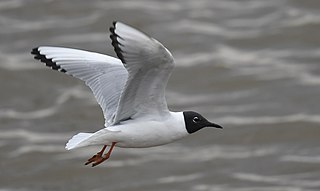
Bonaparte's gull is a member of the gull family Laridae found mainly in northern North America. At 28 to 38 cm in length, it is one of the smallest species of gull. Its plumage is mainly white with grey upperparts. During breeding season, Bonaparte's gull gains a slaty-black hood. The sexes are similar in appearance.

The yellow-legged gull is a large gull found in Europe, the Middle East and North Africa, which has only recently achieved wide recognition as a distinct species. It was formerly treated as a subspecies of either the Caspian gull L. cachinnans, or more broadly as a subspecies of the herring gull L. argentatus. The genus name is from Latin Larus which appears to have referred to a gull or other large seabird, and the species name honours the German zoologist Karl Michahelles.

The Caspian gull is a large gull and a member of the herring and lesser black-backed gull complex. The scientific name is from Latin. Larus appears to have referred to a gull or other large seabird, and cachinnans means 'laughing', from cachinnare 'to laugh'.

Franklin's gull is a small gull. The genus name Leucophaeus is from Ancient Greek leukos, "white", and phaios, "dusky". The specific pipixcan is a Nahuatl name for a type of gull.

The grey-headed gull, also known as the gray-hooded gull, is a small species of gull which breeds patchily in South America and Africa south of the Sahara. It is not truly migratory, but is more widespread in winter. This species has occurred as a rare vagrant to North America, Italy and Spain. As is the case with many gulls, it has traditionally been placed in the genus Larus.

The kelp gull, also known as the Dominican gull, is a gull that breeds on coasts and islands through much of the Southern Hemisphere. The nominate L. d. dominicanus is the subspecies found around South America, parts of Australia, and New Zealand. L. d. vetula is a subspecies occurring around Southern Africa.
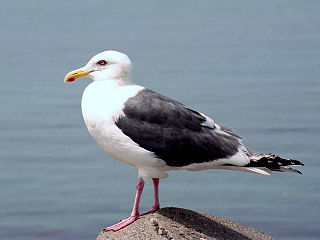
The slaty-backed gull is a large, white-headed gull that breeds on the north-eastern coast of the Palearctic, but travels widely during nonbreeding seasons. It is similar in appearance to the western gull and the glaucous-winged gull. Another alternate name is Pacific gull, though it also applies to a Southern Hemisphere species, L. pacificus.
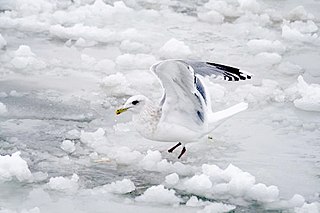
Thayer's gull is a subspecies of the Iceland gull. It is a large gull native to North America.

Hartlaub's gull, also known as the king gull, it is a small gull. It was formerly sometimes considered to be a subspecies of the silver gull, and, as is the case with many gulls, it has traditionally been placed in the genus Larus but is now placed in the genus Chroicocephalus. The species’ name commemorates the German physician and zoologist, Gustav Hartlaub.
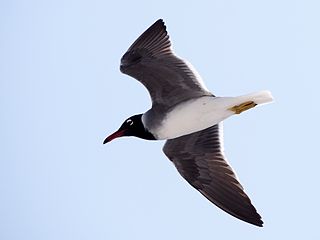
The white-eyed gull is a small gull that is endemic to the Red Sea. Its closest relative is the sooty gull. The species is classed as Least Concern by the IUCN; human pressure and oil pollution are deemed the major threats. As is the case with many gulls, it has traditionally been placed in the genus Larus.

The American herring gull or Smithsonian gull is a large gull that breeds in North America, where it is treated by the American Ornithological Society as a subspecies of herring gull.





